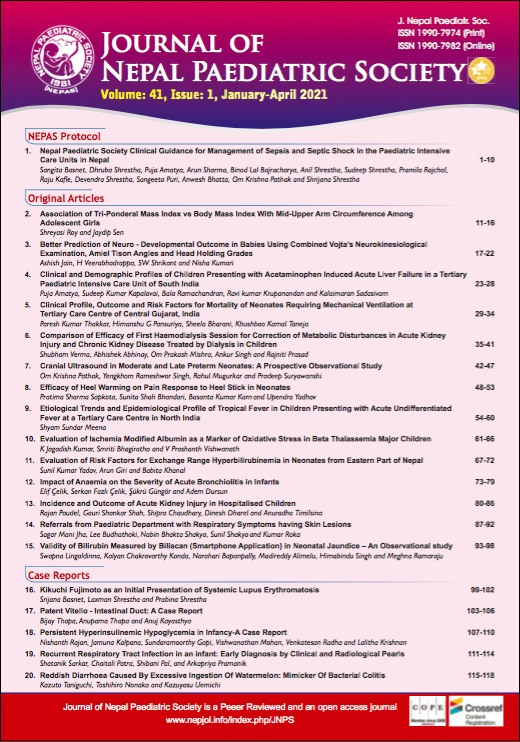Validity of Bilirubin Measured by Biliscan (Smartphone Application) in Neonatal Jaundice – An Observational study
DOI:
https://doi.org/10.3126/jnps.v40i3.29412Keywords:
Bilirubin, Bhutani's normogram, Biliscan, phototherapy, Smartphone, Transcutaneous bilirubinometerAbstract
Introduction: Bilirubin is a frequently ordered investigation in neonatal intensive care units and out-patient practice during follow- up. The gold standard for its estimation is serum bilirubin which is invasive resulting in parenteral apprehension, pain, discomfort and iatrogenic anaemia in a neonate, while the non-invasive measurement by transcutaneous bilirubinometer is not available in all the centres because of its cost. Biliscan is a smartphone application that uses a phone’s inbuilt camera and a colour calibration card to detect neonatal jaundice. We compared bilirubin measured by Biliscan with reference to serum bilirubin among neonates admitted to a tertiary care centre.
Methods: We conducted an observational study from June-2019 to September-2019 at a tertiary care centre in Hyderabad, India. Inborn neonates (greater than > 35 weeks gestational age at birth, and less than a week old) who required bilirubin estimation, underwent both invasive serum sampling and non-invasive estimation by Biliscan. Photograph of the baby’s chest was captured using the colour calibration card of the Biliscan application. Bilirubin values derived from the Biliscan application were compared to those derived from blood samples.
Results: A total of 143 neonates were enrolled. The mean bilirubin value estimated by serum sampling was 11.9 g/dl against 13.1 g/dl of that derived from smartphone application. Biliscan and serum bilirubin showed moderate agreement with a correlation coefficient of 0.6. Bland- Altman plot constructed showed bias of 1.1 with the limits of agreement ranging from -3 to +5.3. Biliscan had a good sensitivity of 90% in identifying high levels of serum bilirubin (> 95th percentile on Bhutani nomogram).
Conclusion: Biliscan application is a non-invasive, real-time, inexpensive and an easily available method that cannot replace serum bilirubin, however can complement and has the potential to help in screening neonates thus facilitating recognition of jaundice early and minimising the number of invasive pricks.
Downloads
Downloads
Published
How to Cite
Issue
Section
License
Authors who publish with this journal agree to the following terms:
Authors retain copyright and grant the journal right of first publication with the work simultaneously licensed under a Creative Commons Attribution License that allows others to share the work with an acknowledgement of the work's authorship and initial publication in this journal.
Authors are able to enter into separate, additional contractual arrangements for the non-exclusive distribution of the journal's published version of the work (e.g., post it to an institutional repository or publish it in a book), with an acknowledgement of its initial publication in this journal.
Authors are permitted and encouraged to post their work online (e.g., in institutional repositories or on their website) prior to and during the submission process, as it can lead to productive exchanges, as well as earlier and greater citation of published work (See The Effect of Open Access).



